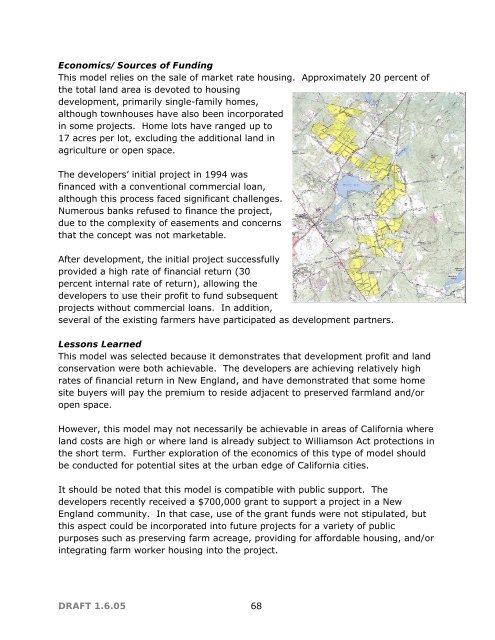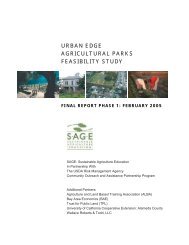A Feasibility Study for Urban Edge Agricultural Parks - SAGE
A Feasibility Study for Urban Edge Agricultural Parks - SAGE
A Feasibility Study for Urban Edge Agricultural Parks - SAGE
You also want an ePaper? Increase the reach of your titles
YUMPU automatically turns print PDFs into web optimized ePapers that Google loves.
Economics/Sources of FundingThis model relies on the sale of market rate housing. Approximately 20 percent ofthe total land area is devoted to housingdevelopment, primarily single-family homes,although townhouses have also been incorporatedin some projects. Home lots have ranged up to17 acres per lot, excluding the additional land inagriculture or open space.The developers’ initial project in 1994 wasfinanced with a conventional commercial loan,although this process faced significant challenges.Numerous banks refused to finance the project,due to the complexity of easements and concernsthat the concept was not marketable.After development, the initial project successfullyprovided a high rate of financial return (30percent internal rate of return), allowing thedevelopers to use their profit to fund subsequentprojects without commercial loans. In addition,several of the existing farmers have participated as development partners.Lessons LearnedThis model was selected because it demonstrates that development profit and landconservation were both achievable. The developers are achieving relatively highrates of financial return in New England, and have demonstrated that some homesite buyers will pay the premium to reside adjacent to preserved farmland and/oropen space.However, this model may not necessarily be achievable in areas of Cali<strong>for</strong>nia whereland costs are high or where land is already subject to Williamson Act protections inthe short term. Further exploration of the economics of this type of model shouldbe conducted <strong>for</strong> potential sites at the urban edge of Cali<strong>for</strong>nia cities.It should be noted that this model is compatible with public support. Thedevelopers recently received a $700,000 grant to support a project in a NewEngland community. In that case, use of the grant funds were not stipulated, butthis aspect could be incorporated into future projects <strong>for</strong> a variety of publicpurposes such as preserving farm acreage, providing <strong>for</strong> af<strong>for</strong>dable housing, and/orintegrating farm worker housing into the project.DRAFT 1.6.05 68





